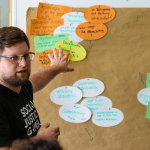Image is illustrative. Amine M’Siouri (Pexels)
The media, and in particular the internet, is a divisive battleground for ideas. It accompanies people in all facets of their everyday lives, including social, cultural, professional and informational. It shapes our opinions, attitudes and choices – whether they are about what to buy, what to wear, where to go or who to vote for. Political parties, big corporations and civic movements use the media strategically in order to develop their agenda. This includes campaigns such as those to raise awareness about the environment, but it is also an effective ground for manipulation and populistic strategies to obtain or maintain power by misleading people. In short, our everyday and political choices are directly connected to the media around us. Politics and the media are heavily dependent on and in a complex relation with each other.
What are the narratives we’re being told? Why these and not others? When it comes to politics, being visible and working well with the media greatly impact election results. After all – how can we vote for someone who we don’t know even exists?
Media is not only a way to strategise and manipulate to get one’s way. Media also holds an important role in guaranteeing democratic participation.
The media are essential to democracy, and a democratic election is impossible without free media. A free and fair election is not only about the freedom to vote and the knowledge of how to cast a vote; it is also about a participatory process where voters engage in public debate and have adequate information about parties, policies, candidates and the election process itself in order to make informed choices (The Electoral Knowledge Network).
This is why
Media and Information Literacy is a key element in making informed choices.
Young people, the media and trust issues
Young people in particular use the internet and social media as their main resource for information, despite having little confidence in the validity of the information they receive, according to a study by Saferinternet.at. A mere 10% trust the information from YouTube, their primary information hub (Saferinternet.at, 2019, p. 2). However, in a study with 14-25 year olds DIVSI found that trust in information strongly correlates with level of formal education, and people with higher academic achievements are more likely to challenge the information they receive online (Meike Otternberg, 2018, p. 68).
A transnational study between Czech Republic, Estonia and Greece delved deeper into the disparities based on education. The study examined the perception of professional and alternative media, and it highlighted a link between trust in government and trust in traditional, professional media. In essence, a lack of trust in government correlates with trust in alternative media (Macková, et al., 2017).
In times of societal change, distrust towards the government and traditional sources of information grows. Traditional media outlets have to adapt to the fast and attention driven news cycle, while remaining under the restrictions of journalistic codes of ethics (link glossary). These restrictions are often not applied to digital media, which enables them to include more opinions into their narratives. Meanwhile, populist parties have set up alternative media channels to shape a parallel narrative to public broadcasting. Through those channels they create an alternate interpretation of facts or even “alternative facts”. Disinformation is running rampant, with sitting governments also embracing the strategy to forward their agenda (Hendricks, 2019).
Alternative news networks are not alone in trying to sway public opinion within states; external actors might try to target the trust in public broadcasting. Many governments seem to have created strategies to either influence the political arena abroad or polish their images inside and outside of their country. When the Cambridge Analytica scandal (Cadwalladr, 2018) broke, people started to worry about targeted political advertisements. However, looking at current strategies, it goes far beyond the scope of personalised ads; in fact, disinformation campaigns create an alternative information sphere, which contributes to the heated contested public discussions we are now used to seeing. A recent study by the University of Oxford traced such disinformation campaigns and identified 70 countries with similar strategies, 7 of which also ran campaigns beyond their own state lines (Bradshaw, 2019).
Media Literacy as a recipe against disinformation
However, the future might not be as gloomy as this sounds. Media Literacy seems to be a universal recipe against disinformation campaigns. While it is not easy to describe the ways in which disinformation is created, spreads and interacts, that information helps users to place the content they see in the right context, without increasing their mistrust and insecurities towards media (Tola, 2019). Not only are we aware of the solution, we are already working on it. Facebook has started collaborating with various fact-checking organisations to investigate the validity of information spread through the platform. While it is still in the early stages and needs a whole lot of improvement, the fact-checking services and debunking websites offer quality information for both users and educators. The websites create content explaining false information (debunking) and explain the networks, origins and dissemination for it (Wikipedia, 2019).
In addition to misinformation being debunkable, an algorithm’s influence (link glossary) might not be as bad as we thought. Since Eli Pariser’s book The Filter Bubble (Pariser, 2011) the assumption has been floating around that users are locked in their own confirmation biases by sorting algorithms of the big search engines. Recent studies have shown that this is not likely the case. In fact, users have never been as informed as today, never used as many resources as today and never been presented with as many information opportunities as today (Newman, 2019).
Last but not least, technology can be used for good as well. The Fridays For Future movement (Fridays For Future, 2019) would not have been possible without social media, networks of young people sharing the idea and spreading the call. By engaging with social and “traditional” media, it has been possible to make the environmental, political and economical demands of young climate strikers heard around the world. While not all media coverage is favourable, the movement builds heavily on social media to spread its messages towards stakeholders. Possibly due to the Streisand effect (Wikipedia, 2019), the controversy against the movement creates media attention and lends it even more visibility.
We should not forget that while the antagonistic discussions in the public sphere seem to challenge democracy, voter turnouts have increased drastically (EP Press room, 2019). In particular, young people have increasingly begun to take to the voting booth and make their voices heard. This too is supported through social network. Promoting election participation through social networks has similar effects on real life. Digital outreach through friends has proven effective (Bond, 2012)!






